
Click here to view with black text on white background

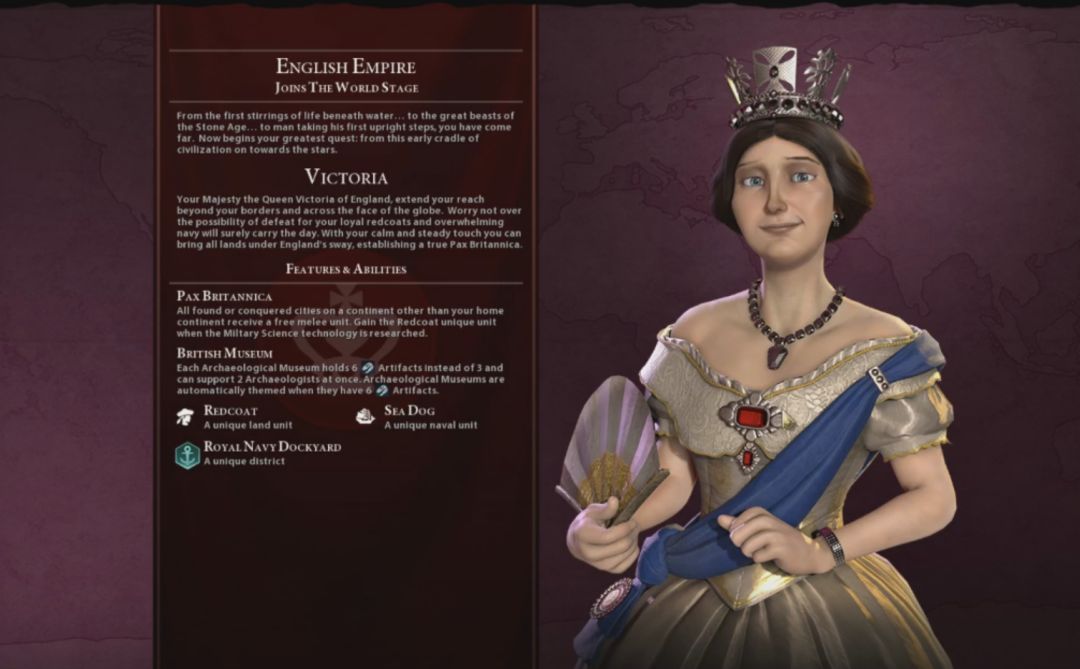
Victoria of England
Standard map, Pangaea, 7 AI Opponents
Prince difficulty
Release Version (1.0)
YouTube Video Playlist (16 videos)
Hello again folks! Welcome back. There's another new Civilization game on the market, and this one looks like it might be decent. In a break with past tradition, BrickAstley decided to hold the first Realms Beyond Adventure game immediately on Civ6's release, staging an unscored event as a way to compare results and introduce the new game to the community. This Adventure One game would also be run using Sirian's old Potluck setup, in which each player would be randomly assigned one of the eight civilizations taking place in the game. Everyone will be playing the same map for this game, but not everyone will be playing the same leader and civilization. This has always been one of our more popular scenario designs, and I thought that it was a good fit as an introduction to Civ6.
When I received my random starting save, it turned out that I had rolled Victoria of England. The early feeling is that this is roughly a middle-tier leader/civ pairing in terms of overall power. As the picture above indicates, Victoria's unique ability is to receive a free melee unit whenever she founds or captures a city on another continent. This is better than it sounds, as even on a Pangaea map there can be more than one "continent" in Civ6. Still, I think this is a relatively mediocre ability, useful for snowballing a conquest game that's already a victory to a faster finish, but not doing much to reach that winning position in the first place.
Victoria gets the redcoat as a unique unit and some kind of sea unit as a bonus second unique unit. I didn't have a chance to use either one very much in this game, and I don't have a sense of whether these are especially useful additions. They both come rather late in the game though, and the online Civ community doesn't seem to think either is that strong. Victoria's best feature is the Royal Dockyard, a replacement for the Harbor district that grants extra movement points to ships. I'll explain more about why this unique district is good to have a little later in this report. Finally, Victoria also has a unique building replacement in the British Museum, an archaeological museum with extra slots for artifacts. This is useful when pursuing a Cultural victory, and otherwise pretty pointless.
Overall, it seems to add up to a fairly average package. I was happy with that, as a middle-of-the-road choice felt like a good fit for my first game. I didn't expect much competition from the AI on Prince difficulty, and I intended to treat this as a bit of a sandbox game, exploring Civ6's gameplay without worrying about any scoring conditions or need for fastest finish. With that in mind, here was the starting position:
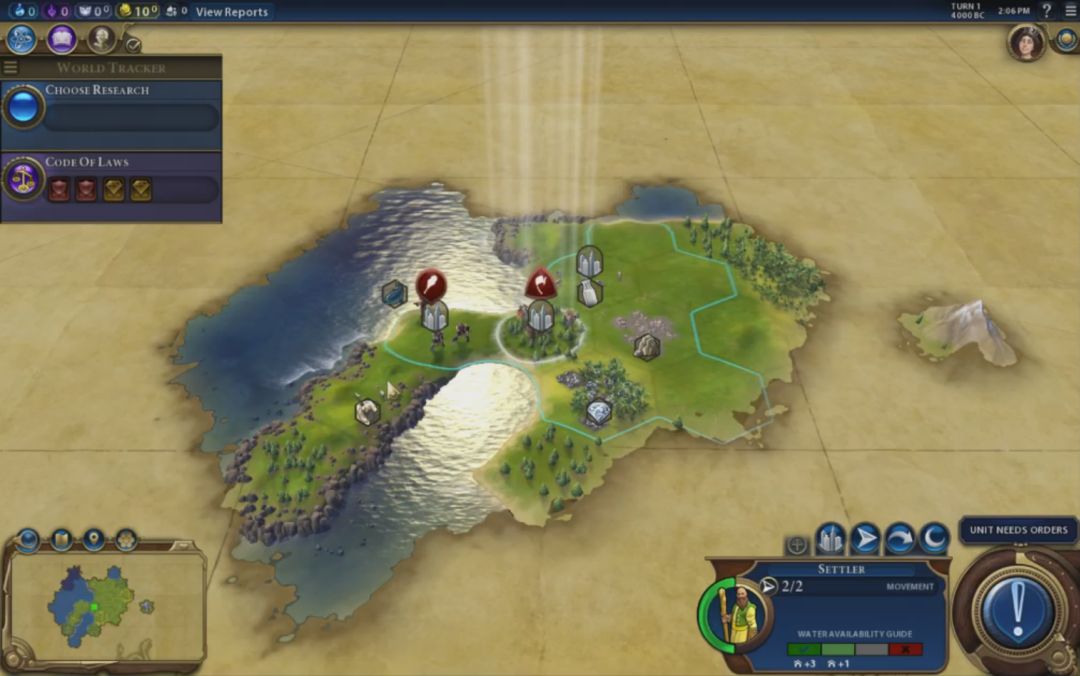
I began next to the sea, which was no surprise since England has a coastal start bias. This starting position had no source of fresh water, but it did have a number of resources present: cows, sheep, fish, stone, and diamonds. That seemed pretty good and most of this land was green, not that I knew very much about what was a good starting location at this point. I founded on the initial tile since there didn't seem to be any particular reason to move. I opened with a scout for my first build, after hearing horror stories about how strong the barbarians can be in Civ6. I opened by researching Animal Husbandry and Mining techs, and with the no-choice option for Code of Laws in the civics tree. It's going to take me a little while to get used to that double research tree concept, with science and culture split into separate options.
By the way, I should note here that Civ6 looks really nice visually. The screenshot above captures some of the lighting effects on water, and the game runs a day/night cycle that slowly changes the time of day while playing. The cities also look really cool when they spread out their districts across multiple tiles, similar to how Civ4 displays all the buildings in a city right there on the map if you zoom in closely, but now spread out over half a dozen tiles. My laptop doesn't have especially great performance specs and Civ6 still looks great on medium settings. I do have to criticize the music, however; every civ is supposed to have their own musical theme in this game, and while that sounds like a good idea, it means that you keep hearing that same theme a lot over the course of hours of playing. Both Civ4 and Civ5 have better music than Civ6 from what I've heard thus far.
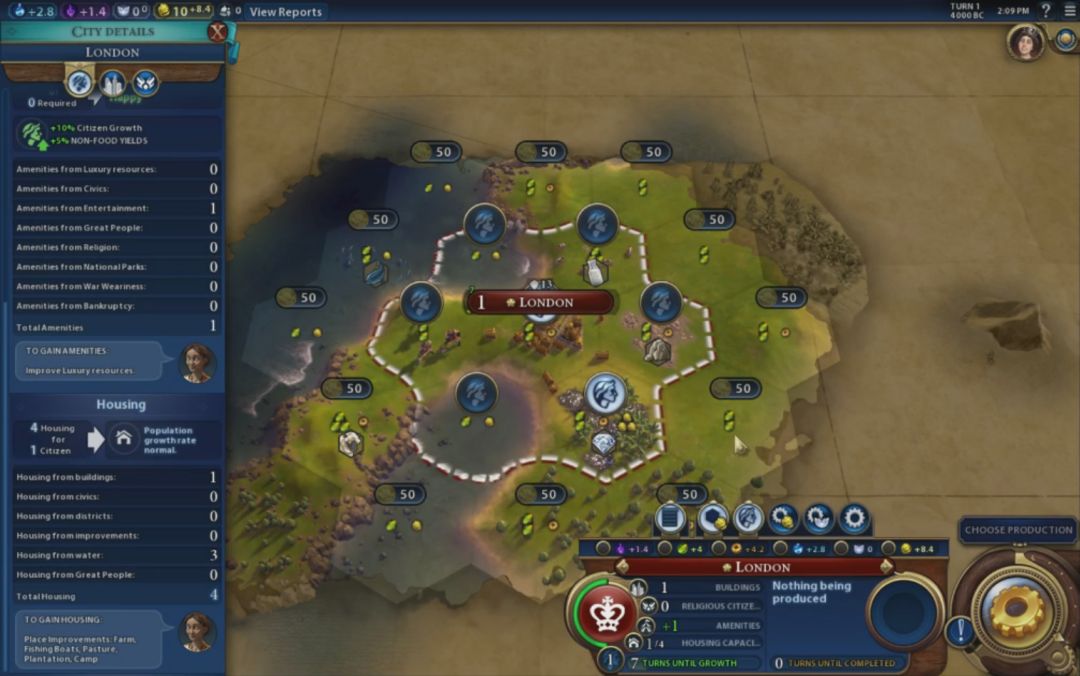
Here's the basic city screen in Civ6, and oof, is this one a mess. The interface in Civ6 never opens up a separate screen for cities, instead popping up these various overlays onto the main game screen. That was a poor decision, and the result is a smorgasbord of bad interface design. There are six different submenus accessed by clicking the icons above the culture/food/production/etc. displays right next to the city name. I've clicked the "City Details" submenu right now, the leftmost icon that looks like a scroll or piece of paper. Continuing from left to right, the other five are for purchasing tiles with gold, assigning city population to tiles or specialists, purchasing units/buildings with gold, purchasing units/buildings with faith, and finally the production menu itself. This means that assigning your citizens to tiles and choosing what to build in the city are actually located on two different submenus, which is the height of stupidity in a Civilization game. Furthermore, the interface does not update when you reassign tiles; if you swap from a high food to a high production setup, the number of turns to grow and finish production won't change, not unless you select a different production order, which then belatedly updates the interface. Yeesh. 
It's actually worse than that though. The City Details submenu has three further sub-sub-menus, indicated by the three icons on the left side of the screen under the word "London". The one I have selected here details the housing and amenities situation in the city. Housing and amenities are essentially your health and happiness in Civ6, and cities need both to keep growing. This is very important information, and that's why both are displayed in a shorter form in the main city menu on the right side of the screen. Still, I feel like this submenu is completely unnecessary, and could have been handled with a mouseover tooltip of the amenities and housing information on the main city menu. This panel is then covering up the other two sub-sub-menus, one of which lists all the buildings and districts present in the city (which is pretty freaking important information to be buried so deeply in the interface!), and the other which explains the city's faith situation. Why is this information buried in so many different menus? Why isn't there one interface that displays everything at one glance?
Making this all even more frustrating is the fact that Civ6 goes out of its way to avoid giving the player any concrete information on numbers. Everything is listed as "Turns until growth" and "Turns until completed". But the game won't tell you the actual food needed to grow, or the actual amount of production invested into a build, not even with a mouseover tooltip. Nor does the game tell you the current food surplus, which is much more important than the total food being produced. London is running +2 food here, which is more relevant than the 4 total food, half of which is required to feed its 1 population point. I mean, I can do these sums in my head, it's just annoying and should be unnecessary. By the way, have I also mentioned that Civ6 won't tell you how much culture you need to expand to another tile, or what tile is going to be chosen next? All of this information is present in the game (there are mods already that will display it), however the current interface reveals nothing.
Oh, and you also can't choose to name your own cities or rename them right now. That's one of the most basic programming tasks possible, a simple text replacement, and the interface doesn't allow that either. Somebody at Firaxis was smoking something pungent on this one.  This whole thing is really, really bad at the moment. Try comparing to a screenshot of a city from Civ4 to see how a vast amount of information can be displayed in an easily-accessible format. While I can work around this disastrous interface because I like the Civ6 gameplay, it's depressing to see how far the city menu has regressed over the last decade. Civ5's interface for city management was bad, and it was still significantly better than Civ6. Firaxis, please work on this in patches.
This whole thing is really, really bad at the moment. Try comparing to a screenshot of a city from Civ4 to see how a vast amount of information can be displayed in an easily-accessible format. While I can work around this disastrous interface because I like the Civ6 gameplay, it's depressing to see how far the city menu has regressed over the last decade. Civ5's interface for city management was bad, and it was still significantly better than Civ6. Firaxis, please work on this in patches.
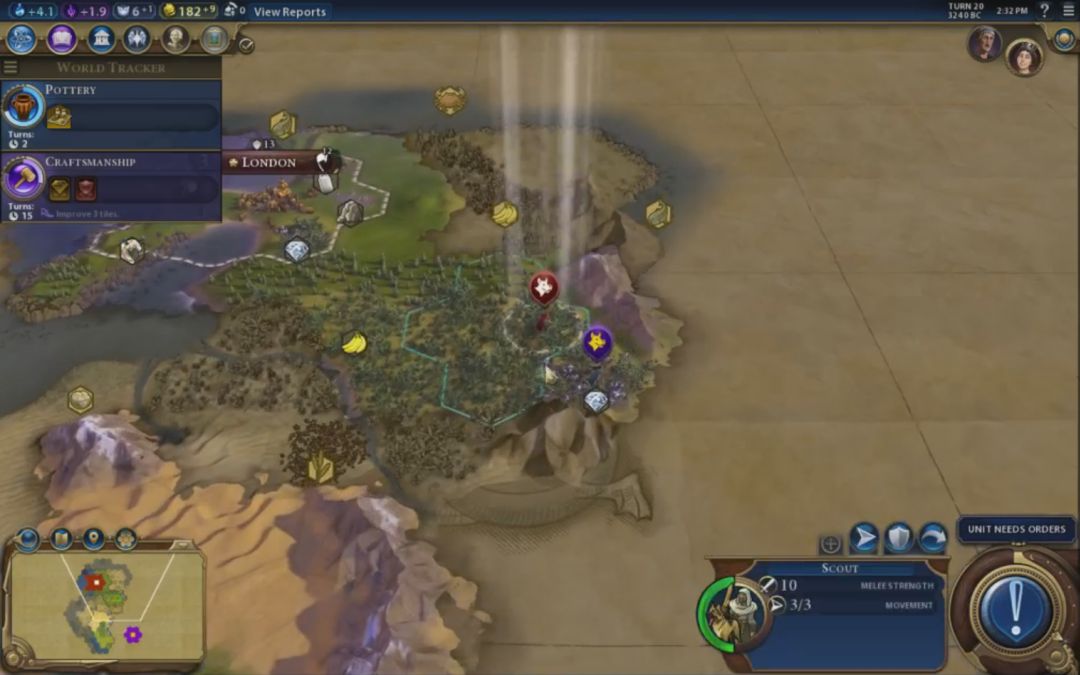
Oh right, there was a game taking place here too. I found Rome pretty quickly off to my southeast, with their capital visible on the minimap. There's a diplomatic option now to exchange information about capitals upon first contact, and I kind of like that to get a sense for where your rivals are located early on. (There's no map trading in Civ6, so this is about the only way to reveal parts of the map without sending units to explore.) It was clear already that I was going to be constrained on land by the presence of Rome. There was a desert to the south, heavy rainforest off to the east, and ocean everywhere else. There was room for one good city near the river, by the bananas and wheat resources, but I didn't see anywhere else that looked too promising for expansion. I would likely have to go through Rome or turtle on this starting peninsula.
This was starting to look like it wasn't the best location for a capital. I hoped it would make for an interesting game though.
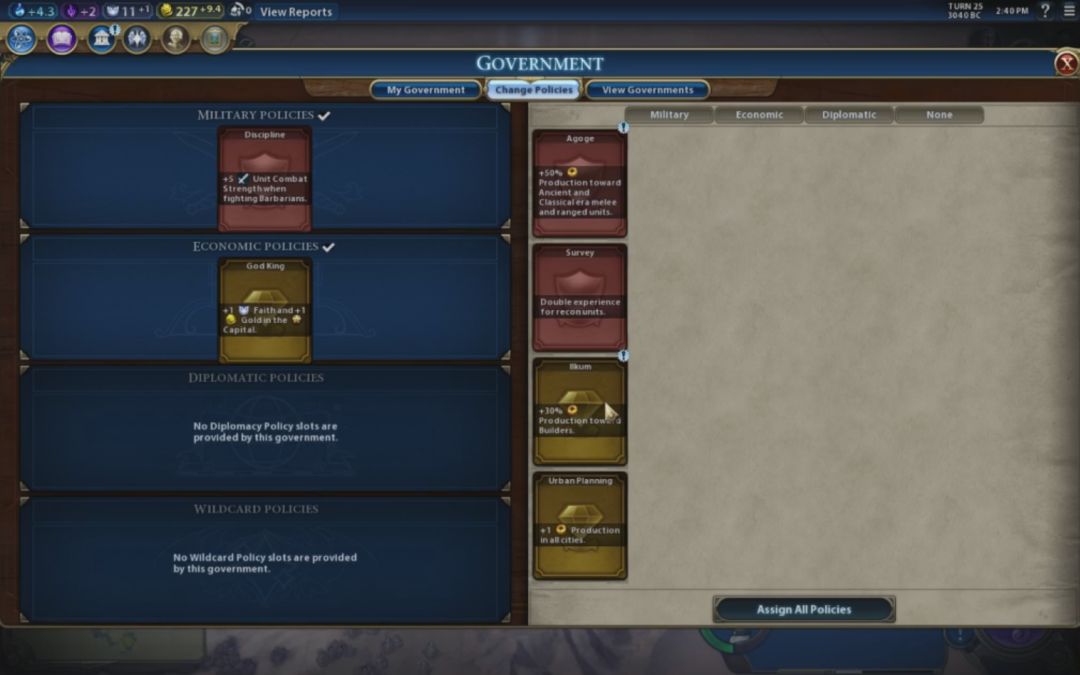
I need to discuss the civics and government system briefly as well. For anyone who hasn't been following Civ6's development, the game uses a combination of the civics system from Civ4 and the social policies from Civ5. All of the civics are located in the culture tree, a separate research tree that functions just like the normal tech tree, only using culture as its currency instead of beakers. When these civics are finished being researched, they can be selected for use in your government, with each policy having a specific flavor: Military, Diplomatic, Economic, or Wildcard. Different governments have different benefits and differing numbers of policy slots. This screenshot shows the first and most basic government, Chiefdom, which has 1 Military policy slot and 1 Economic policy slot. Later governments have significantly more policy slots, and of course you'll have many more policies to choose between by then too. The player can choose a new government and new policies for free every time that they finish researching a civic, or can pay gold to change at any other point in time.
I love everything about this system.  As I wrote in my pre-release thoughts on Civ6 article, it combines the civics swapping system from Civ4 with the "culture is important for more than just popping borders" system from Civ5. With a few games under my belt now, I find myself targeting certain policies and planning my strategy around them. The policies themselves can be quite powerful, for example the early policy that adds a +50% bonus to settler production. Hey, you want to be Imperialistic from Civ4 any time you want? Now you can be! There are also policies that give +50% or even +100% to unit production, policies that give builders (this game's version of workers) extra charges, and a whole bunch of different economic policies that boost science or culture or faith or whatever. Intelligent use of the civics system goes a long way towards success or failure in this game.
As I wrote in my pre-release thoughts on Civ6 article, it combines the civics swapping system from Civ4 with the "culture is important for more than just popping borders" system from Civ5. With a few games under my belt now, I find myself targeting certain policies and planning my strategy around them. The policies themselves can be quite powerful, for example the early policy that adds a +50% bonus to settler production. Hey, you want to be Imperialistic from Civ4 any time you want? Now you can be! There are also policies that give +50% or even +100% to unit production, policies that give builders (this game's version of workers) extra charges, and a whole bunch of different economic policies that boost science or culture or faith or whatever. Intelligent use of the civics system goes a long way towards success or failure in this game.

Meanwhile, I had constructed a builder to improve some of the tiles around my capital, followed by a settler to go claim the fertile river location to the southeast. Builders in Civ6 get a set number of "charges", which instantly improve a tile when used. The default number of charges is three, which can be increased by some policies and wonders and civ abilities. Builders disappear when all of their charges have been used. Replacing workers with builders feels like a smart decision to me, at least so long as the Civilization series continue to use the One Unit Per Tile rules. Workers in Civ5 took way too long to construct tile improvements, and they couldn't be grouped together due to the tile restrictions. This is definitely a better system than that. Thumbs up from me on this particular change.
One of my other favorite things about Civ6 is that expansion is finally back again. No more per-city penalties for culture or science, woo hoo!  Settlers are relatively cheap to build, and there's no reason not to push them out and claim your share of the land. The key limiting factor on expansion appears to be access to fresh water, as early game cities tend to be quite weak unless they have a source of water to provide housing. The AI is also really bad at expanding right now, and doesn't push out settlers for new cities nearly fast enough. I'll have more to say on this topic later in this report. Fortunately though, the general mechanic is a winner here. Civ is back to being a game of expansion, the way it should be. This is the single biggest thing that ruined Civ5 for me, and it's gone gone gone.
Settlers are relatively cheap to build, and there's no reason not to push them out and claim your share of the land. The key limiting factor on expansion appears to be access to fresh water, as early game cities tend to be quite weak unless they have a source of water to provide housing. The AI is also really bad at expanding right now, and doesn't push out settlers for new cities nearly fast enough. I'll have more to say on this topic later in this report. Fortunately though, the general mechanic is a winner here. Civ is back to being a game of expansion, the way it should be. This is the single biggest thing that ruined Civ5 for me, and it's gone gone gone.

I thought that I would highlight the in-game scoring system in another screenshot. Unlike Civ4 and Civ5, this information is no longer displayed on the main screen and is instead hidden in a separate victory conditions menu. Scoring seems to be based on research completed into techs/civics, Great People produced, wonders built, something involving religion, and finally the "empire" category, which is either population-based or territory-based on some combination of both. Hopefully we'll get more information about where these numbers are coming from in time. There is no Demographics screen at all in Civ6 at present, not even the crummy one that Civ5 had, which means that this is the best comparison that the player gets while the game is in progress. Oddly enough, the game is tracking a lot of the traditional bar graph data, however it hides all of this until after the game is finished. This is another decision that makes no sense to me - bring back the Demographics screen, please!
I should also discuss the "boosting" system for techs and civics. If you look at the research windows at the top left side of the screen, you'll see that there's a small arrow under both my science and culture projects, with a condition attached to each one. The science arrow is lit up because I've fulfilled that condition and gotten the boost for Irrigation tech (these are officially called "eurekas" for science and "inspirations" for civics, but everyone seems to be using the word "boosts" instead, which I'll also use here). These boosts are essentially mini quests to fulfill for every tech and civic, and when completed they award 50% of the total cost of the tech/civic. They definitely make a huge difference, and players would be wise to grab them wherever possible.
Opinion in the Civ community seems to be pretty mixed about this gameplay introduction. I understand the complaints that this feels like a form of Facebook gaming, rewarding players for things that they would have been doing anyway, and I've also found myself getting boosts for techs/civics that I wasn't even aware of while playing. When the boosts appear to pop up randomly, it definitely feels like a bad system. However, I actually do like this mechanic, and I don't think it's getting as much credit as it deserves. The further that the player progresses into the tech and culture trees, the more difficult the boosts become to achieve, to the point where it's rare to be getting very many of them at the end of the game. It's also worth noting that the boosts never change from game to game - you are always tasked with the same quests to achieve. In some games this will be trivial, and in others it may be impossible. This means that players can base their strategy around those boosts, knowing ahead of time what needs to be done to get them. I think that this is a system with a "burden of knowledge" penalty; once the Civ community has leared the tech/civic trees inside and out, the boosts will stop being a case of "oh hey I got a boost for something and I have no idea why" and become a situation of "ok I have a watermill under production to boost Construction tech which will then boost Games and Recreation civic so that I can get started on the Colosseum to solve my amenities crunch." The system rewards careful planning and managing progress through two different research trees to save as many beakers/culture as possible. And sometimes it's still worth researching unboosted techs/civics anyway, because their benefits are worth having immediately. I think that sets up some interesting decisions on the part of the player. Once we all have these techs/civics memorized, I think we as a community will like this mechanic a lot better. If that means sometimes players will stumble into boosts unknowingly, I'm OK with that. (My biggest issue with this system is the fact that the AI seems to have no idea how to use it, but that's a separate topic.)

I didn't see a lot of barbarians in the early stages of this game. The somewhat cramped start with nearby oceans and Rome as a close neighbor kept barb spawning down to a minimum. I think I had one warrior and one scout, and that was enough to keep the minimal barbarian presence at bay. I took this screenshot to demonstrate the promotion tree for melee units like this warrior. The tree itself is pretty bland; there are few options to choose from, and getting extra combat strength is almost always a no-brainer. I can't say I like this very narrow system for promotions. However, the experience system itself is a lot better than in Civ5, with its insta-heals and mechanic of "you must take a promotion immediately upon earning it". Here in Civ6, promotions will heal the unit in question for 50 HP (half of the total lifebar) when used, and promotions can be saved indefinitely. However, units will not earn more experience until they are promoted, and taking a promotion instantly ends that unit's turn. This is an interesting dynamic that allows for player choice and presents a meaningful tradeoff. It might be better to hold a promotion for a long time for the healing, but that unit won't be getting more XP, and it has to burn a wasted turn to get the heal. Like so many of Civ6's mechanics, this is a refined and superior version of Civ5's setup.
There is one flaw here, however: the graphical display for unit experience is almost totally invisible! There is a miniscule bar that fills up at the bottom of the unit box. Look at where the game lists "Warrior" in the bottom right, and then look at the very bottom of that box. There is a tiny white bar there with microscopic text that says "XP" and mousing over that bar will tell the unit's experience total in numbers. Once again, the interface design is abysmal. I swear that bar is about 10 pixels tall and is using about one percent of the vertical space on screen. Who in the world thought this was a good idea?!?
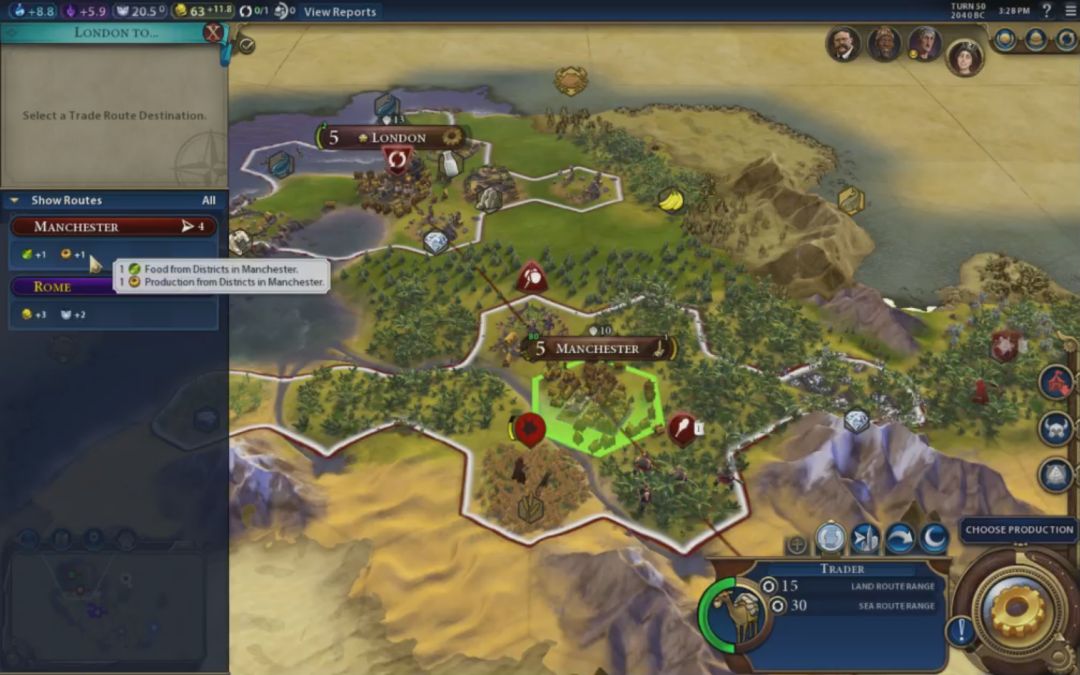
On Turn 50 of the game, I finished a trader unit and had the chance to create my first trade route. These are back from Civ5 and work in much the same way, creating food/production/gold when run between cities. Interestingly they actually work in reverse from Civ5; in this game, it's the STARTING city that gets the free yields, not the DESTINATION city as it was in Civ5. Trade routes are weak in the early game but quickly ramp up in power, to the point where they can produce something like 8 food / 6 production by the end of the game. That's per trade route, mind you. The player gets one trade route for free on the tech tree, and then the rest come from districts: one additional trade route for each Commercial district and Harbor district. There is also no limit to the number of trade routes that can be run out of a single city, and jump-starting new cities with a series of trade routes is a good way to get them off the ground in the late game. Trade routes are therefore extremely powerful, and the current Civ6 metagame is to rush Commercial districts everywhere to get as many of them going as possible. (I did not know this while playing on release day, of course!) Unfortunately, trade routes are also extremely tedious to manage, which is part of the reason why you'll see me playing Small and Tiny maps for the time being. I don't want to manage 27 trade routes, thank you very much, and they're essential to playing at a high level right now. I expect they will be nerfed in a future patch in some way, as trade routes are a little too good at the moment.
Trade routes are also the way that roads are created in Civ6. Builders can't create them, and the only other unit that can create roads (the military engineer) is woefully weak and underpowered at present. Anyway, traders are clearly intended to be the main road-constructing force in Civ6. As they walk between cities, they create roads along their path. Roads automatically update between eras, getting better in the medieval, industrial, and modern periods. I think this is generally a pretty good system, except for one thing: roads currently don't do much of anything to increase movement! Ancient roads just treat all land on them as being flat ground: they seem fine to me. Medieval roads cost 1 movement point per tile. Industrial roads cost 0.75 movement points per tile. That sounds nice, except that nearly all units in this game have 2 moves, and so it costs 1.5 movement points to cross through 2 tiles of Industrial roads... leaving 0.5 movement left over, not enough to move a third tile. As a result, Industrial roads are no faster than Ancient roads... or moving through flatland wilderness in 4000 BC. What the heck. Modern roads finally drop the movement cost to 0.5 points per tile, so yes, at the very end of the game, your units can move a whole 4 tiles along roads. Thanks for that. Somebody beef up the roads and make them more useful please!
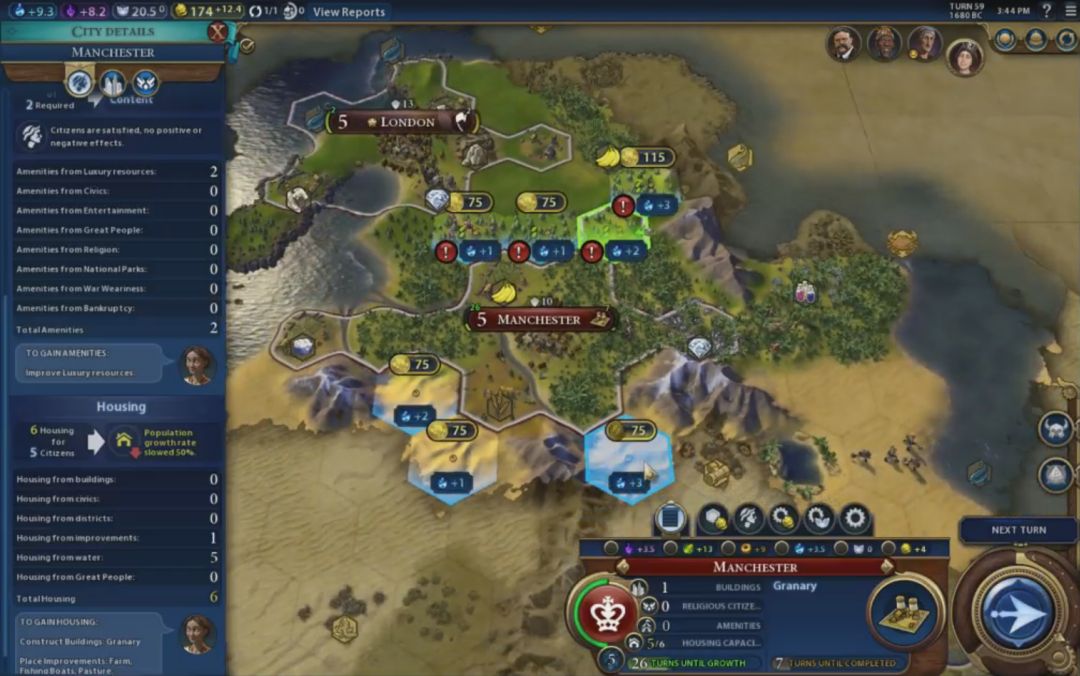
Here in this picture I'm about to place a district. This is the biggest innovation in Civ6, the unstacking of cities and the creation of the districts, and they work pretty well in practice. I'm building a Campus district here for science, and they get bonuses for being located next to mountains and rainforest. There was a very nice location in the desert next to three mountains to the southeast of Manchester, and I thought that was worth spending the 75 gold to purchase the tile and unlock it. Those three mountains would be worth +3 beakers per turn, not bad at a time when my entire empire was only producing 9 beakers/turn! Figuring out the city-building jigsaw puzzle created by the districts is an entertaining exercise, and another system that heavily rewards planning ahead of time. Districts cannot be removed once built, and as a result poor planning can get the player badly stuck, especially with some of the districts that have stringent requirements about where they can and cannot be placed. This is another system that I think gets better with more experience, as the disparate pieces start to come together and create some really fun city planning. Honestly, this system is probably too complicated for the average player. You really need to lay out where the districts and tile improvements are going to go at the time of a city's founding for optimal results, and that sort of thing is only going to appeal to expert players. I'm not complaining though, the mechanic is great and has a lot of depth.
Note as well that Manchester has reached the housing cap, which is why it's building a granary for +2 housing. I've found that housing tends to be the biggest limit on cities in Civ6, with amenities typically being a much lesser concern. If a city is within 1 point of the housing limit (so for example here 5 population with 6 housing), then growth is slowed by 50%. Ouch, that's a harsh penalty!  If population = housing or is higher than housing, then growth is slowed by 75% (!), and eventually growth ceases entirely at something like population being three points higher than housing, although I have no idea how a city would ever reach that point. This is the reason why fresh water is so important in the early game, as it provides 5 housing for free. Settling on the coast provides 3 housing, and settling next to neither provides 2 housing... which means the city already has the 50% growth penalty at size 1. Ouch. Those cities are definitely not worth founding until much later. Granaries provide +2 housing, and farms/pastures provide +0.5 housing apiece. Otherwise, there's not much to do about housing until reaching aqueducts, sewers, and eventually neighborhoods further down the tech tree. It certainly looks to me that early cities absolutely must have native sources of fresh water, and then later in the game technology will allow for settling in the more arid parts of the map. That's pretty accurate historically, and seems to work reasonably well as a gameplay mechanic.
If population = housing or is higher than housing, then growth is slowed by 75% (!), and eventually growth ceases entirely at something like population being three points higher than housing, although I have no idea how a city would ever reach that point. This is the reason why fresh water is so important in the early game, as it provides 5 housing for free. Settling on the coast provides 3 housing, and settling next to neither provides 2 housing... which means the city already has the 50% growth penalty at size 1. Ouch. Those cities are definitely not worth founding until much later. Granaries provide +2 housing, and farms/pastures provide +0.5 housing apiece. Otherwise, there's not much to do about housing until reaching aqueducts, sewers, and eventually neighborhoods further down the tech tree. It certainly looks to me that early cities absolutely must have native sources of fresh water, and then later in the game technology will allow for settling in the more arid parts of the map. That's pretty accurate historically, and seems to work reasonably well as a gameplay mechanic.
Needless to say, London was not on fresh water in this game, and it was soon eclipsed by Manchester in my game. Making matters worse, London didn't have the terrain to build an aqueduct either, which put it even further behind in the housing department. In retrospect, this was a pretty terrible capital location, and I didn't realize what a challenging starting position this had truly been until reading some of the other non-England reports. No fresh water at the capital is a major handicap in Civ6.
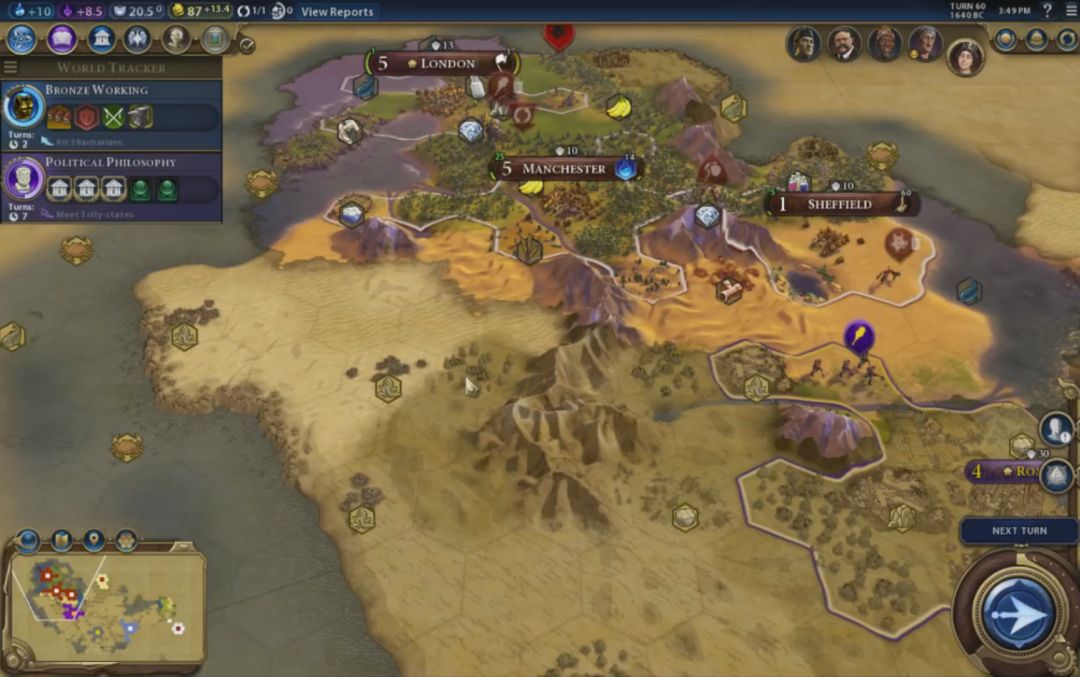
After having seen this in practice, I placed my third city at the only available source of fresh water remaining to me, the tiny little desert oasis off to the east. Sheffield wasn't the best spot in an abstract sense, but it was what I had, and I made use of it. Anything with fresh water is worth settling in my opinion. When to settle the rest of the map... I'm still trying to figure that out!
The rest of the starting area wasn't especially appealing. Desert to the south, and room for one more dry city on the northeast coast. I was building a settler for that location in the picture above, only to have a barbarian camp pop up in that vicinity. The camps are always visible in the fog of war if you've explored that area previously, and you can just see the barbarian camp icon up in the far north next to the barb scout. I had exactly one warrior back at home for military at this point, which had been sufficient up until now. However, those barbs quickly showed me that I needed some more troops:
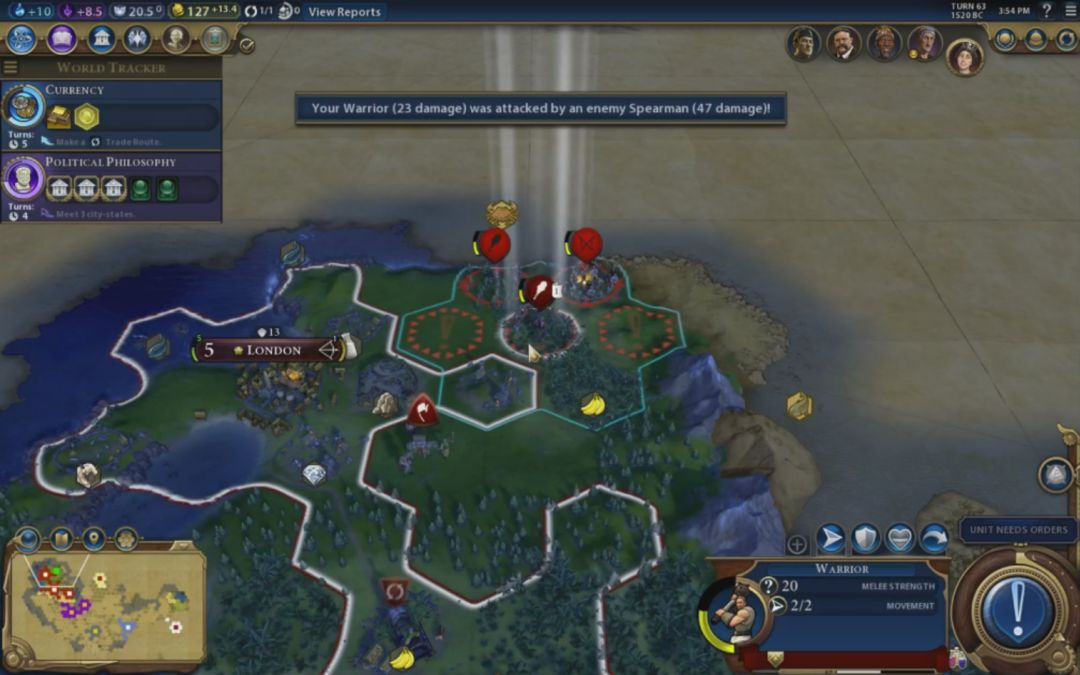
Yeah, one warrior isn't going to cut it here. I had been hoping to sneak the settler past this barbarian camp over to the east coast, and I proved unable to do so. That camp spawned a steady stream of barbarian warriors and spears over the next few turns, and I had a devil of a time holding them off. I'm building archers now to stem the flow of invaders, with the policy that provides +50% production for ranged units (Agoge), and those archers will eventually be sufficient to clear the camp. This was completely my own fault, of course. I'd heard the warnings about barbarians and still didn't take them seriously enough. I won't be making that mistake again. Now the barbarians didn't actually do anything - no units lost, nothing pillaged - but they were able to delay the settling of my fourth city by almost a dozen turns, with the settler sitting around having to wait around back in London. Argh! I hate inefficiencies like that! Next time, build more archers.
I had been researching the Political Patronage civic, which unlocks the game's first real governments. I could not find a third city state to boost that one, which would have saved a lot of time. In any case, here's what the government screen looks like:

There is a choice here between Autocracy, Oligarchy, and Classical Republic. Each one has certain innate benefits, but the main thing as far as I'm concerned are the policy slots that each government enables. I saw a lot of people in the other Adventure One reports using Autocracy, in part due to that description that says "capital receives +1 boost to all yields". Unfortunately, this is not +1 to all *TILE* yields, but rather just +1 to all yields. In other words, the capital gets +1 food, +1 production, +1 culture, etc. It's pretty underwhelming as a choice. Autocracy also has 2 military policy slots, and I've found them to be the least desirable as a group. Perhaps it's different for a military game; I don't know, as I haven't tried that approach yet.
I've been running Classical Republic instead in my games. This is mostly for the 2 economic policy slots, as I've found the economic slots to be the most useful ones overall. Those are the ones with boosts to settler and builder production, boosts to district adjacency benefits, boosts to housing and amenities for cities, and so on. To put it in Civ4 terms, there's a reason why our Multiplayer community spent a lot of time in Representation civic and not a lot of time in Police State civic. Civ is an economic game first and foremost, and if you have the economy edge, you generally have the military edge too. We'll have to see if my opinion on this changes with time and experience. For now, Classical Republic looks like the clear winner to me, and the same with Merchant Republic further down the civics tree (more trade routes, discounts on gold purchases, and 2 economic / 2 wildcard policy slots? Yes please!)
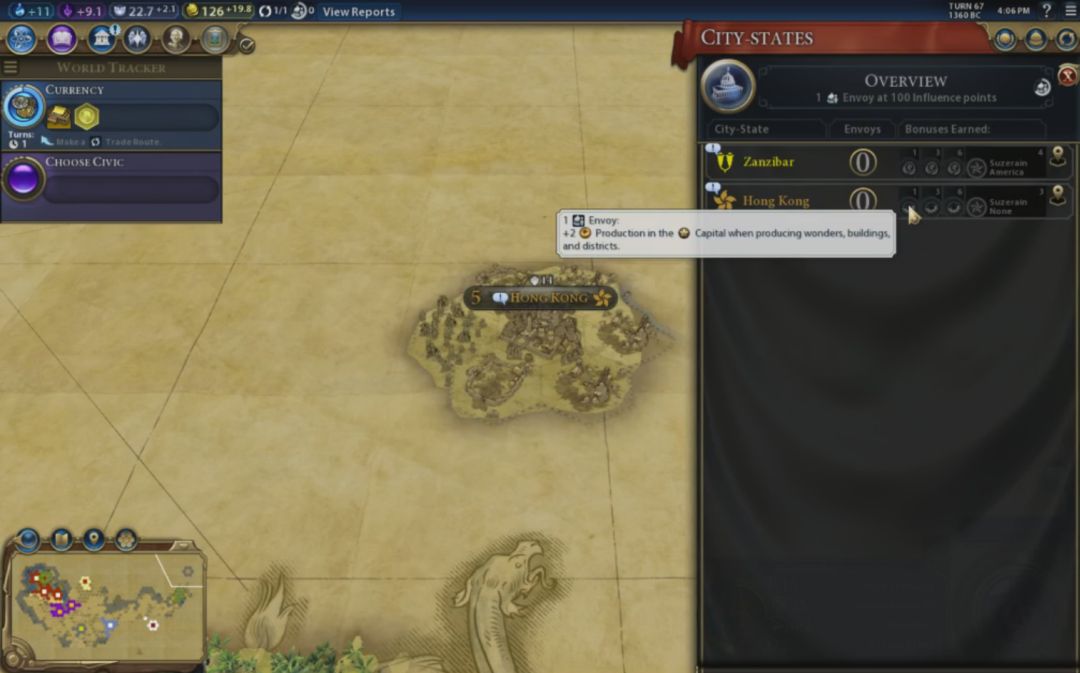
I also want to talk about how the city state system works in Civ6. All of the city states award benefits based on how many "envoys" they have been sent by the main civilizations competing in the game. If you are the first to meet a city state, you receive one free envoy at first contact, and that's significant because there is a benefit from every city state for sending the first envoy. For the highlighted example of industrial city state Hong Kong, that's +2 production in the capital for non-military builds, quite nice in the early game. City states award more benefits at 3 envoys, and more again at 6 envoys. These benefits are district-based, so for example Hong Kong (like all industrial city states) provides extra production in each completed Industrial district; I think it's +2 production per district at 3 envoys, and another +2 production per district at 6 envoys. That's for all districts of the type associated with the city state, mind you, so if you have a dozen cities with Industrial districts, they're all getting the benefit. Not bad.
Each city state also has a unique benefit that accrues only to the "suzerain", the civ which has sent the most envoys to that city state (minimum = 3). These suzerain benefits are all individual to that particular city state and don't repeat. Hong Kong provides cities with +20% production towards city projects as its suzerain benefit, which is situationally useful. Envoys are generated over time based on the government and diplomatic policies that your civ is running. City states also award quests which will produce additional envoys when completed. The quests are random like Civ5, but they only award one envoy for completion, and tend to be more difficult to complete. There is also no mechanic to pay city states gold for more envoys; the player must earn them via quests or (more commonly) through their government and diplomatic policies. This whole system is vastly better designed than the city states in Civ5, and I've been enjoying it thus far. Where to send the envoys can be a tricky decision, dependent upon the player's goals for the game as well as what the AI empires are doing with their own envoys. The city states are probably the best-designed aspect of the diplomacy at present, since the diplomacy with the actual AI leaders is a complete mess currently.
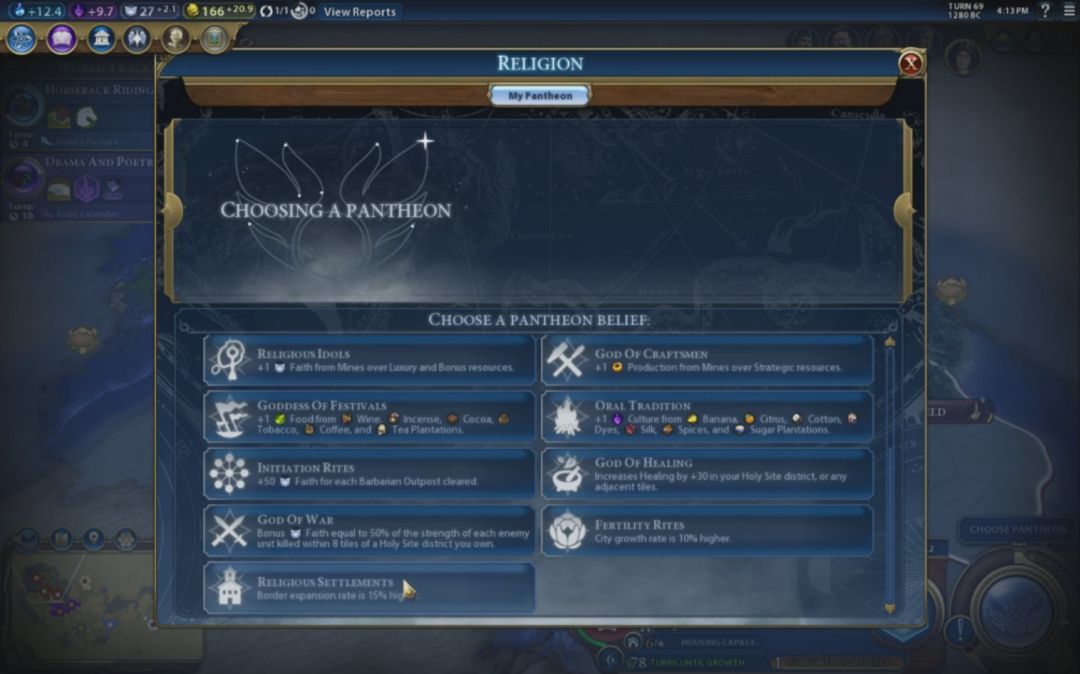
Shortly thereafter, I ended up with enough faith to establish a pantheon. I now know that civs found pantheons in this game after accumulating 25 faith, and I had earlier spent a long period of time sitting on 20 faith not generating any more. That was a definite mistake there, one of those things that you just won't know during your first playthrough. Anyway, every civ gets a chance to found their own pantheon in Civ6, which is essentially a separate thing from the religions that come later. Your cities always make use of your pantheon belief, and they don't have to be converted. I didn't see anything that matched my start too closely, and ended up taking Religious Settlements as a bit of a default option. Borders grow very slowly from culture in Civ6 (with no Tradition social policies from Civ5), probably too slowly in my opinion, and this helps nudge them along a bit. Fertility rites is also always a good option, along with a bunch of the resource-specific options that fit individual starts. Desert Folklore has been heavily nerfed and now provides +1 faith for every desert tile adjacent to a Holy Site district, which is fortunately much more balanced. No more endless free faith from working floodplains and desert hills.
Founding a religion is a different process. It requires recruiting a Great Prophet, who will then found the religion at a Holy Site of the player's choice. Great Prophet points are generated through building Holy Sites and the religious buildings that are located within them, so if you don't build Holy Site districts, you won't be founding your own religion. I didn't do much with religion in this game and resolved to explore the system in another game later.
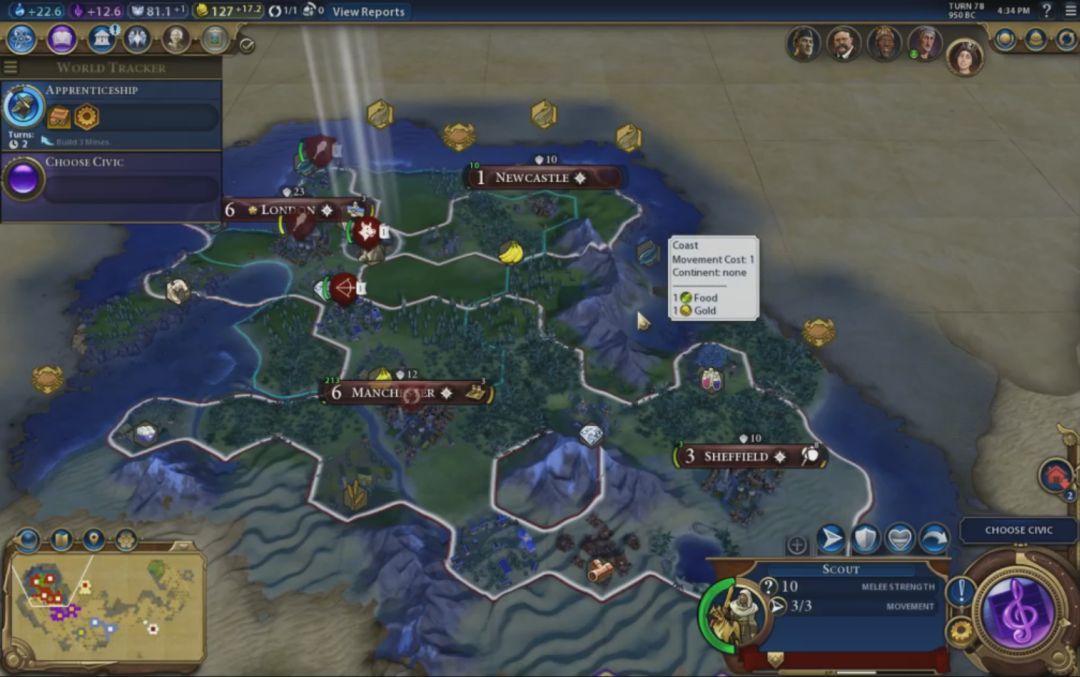
Here's my little empire around 1000 BC. I was finally able to get that settler over to the northeast coast and establish Newcastle, taking me out to four cities. I don't think this showing had been particularly impressive to date, mostly me experimenting and trying to figure out how the gameplay worked. I will highlight the current research though; Apprenticeship is one of the key techs to beeline in Civ6. It allows Industrial districts to be constructed and also adds +1 production on mines. Amazingly, the bonus to mine production doesn't even get an icon on the tech tree, only displaying when the tech is moused over. Again, the interface in Civ6 is bafflingly terrible for no real reason. Since there's no Slavery civic in Civ6 and food tends to be pretty easy to come by, production is the key limiting factor. Anything that increases production is very good to have. Apprenticeship offers the Industrial district and a boost to tile yields, making it a very hot commodity indeed. I suggest prioritizing this heavily.

And here's my poor capital, stuck at size 7 for lack of housing. London is currently getting a -75% penalty to growth as a result of being at population = housing. That's completely brutal and it means this city is effectively unable to grow at all until something arrives to solve that housing crunch. I've essentially done all that I can here: I have a granary finished, I have pastures in place for the minimal extra housing that provides, and so on. What's really killing me is that London can't build an aqueduct, which would provide 3 more points of housing. Aqueducts have very strict requirements: they must be on one of the tiles next to the city center, and also next to a source of fresh water or a mountain. This oddly means that you can plant cities in some very dry locations as long as they're next to a mountain. London had no mountains and no fresh water, meaning it was out of luck. It would end up stagnating for a long time until I could finally open up more sources of housing.
The other thing I'm highlighting here is the way in which specialists are run in Civ6. Because London can't grow, I've taken one of the pop points and stuffed it into the library that I built in the Campus district. The interface is not especially clear here, but that specialist is producing 2 beakers/turn. I don't recommend using specialists too much in this game unless you're at the housing cap or have no good tiles to work; for example, I would probably be better off here mining the grassland hill tile north of the capital, which would become a 2 food / 3 production tile. The interface also doesn't make specialist use very clear, which should come as no surprise if you've been reading this report to date. Still, there are times where specialists can be useful, and this is how you make use of them.
Because I had built two early Campus districts, I was generating a lot of Great Scientist points, and soon had the chance to claim my first Great Person:
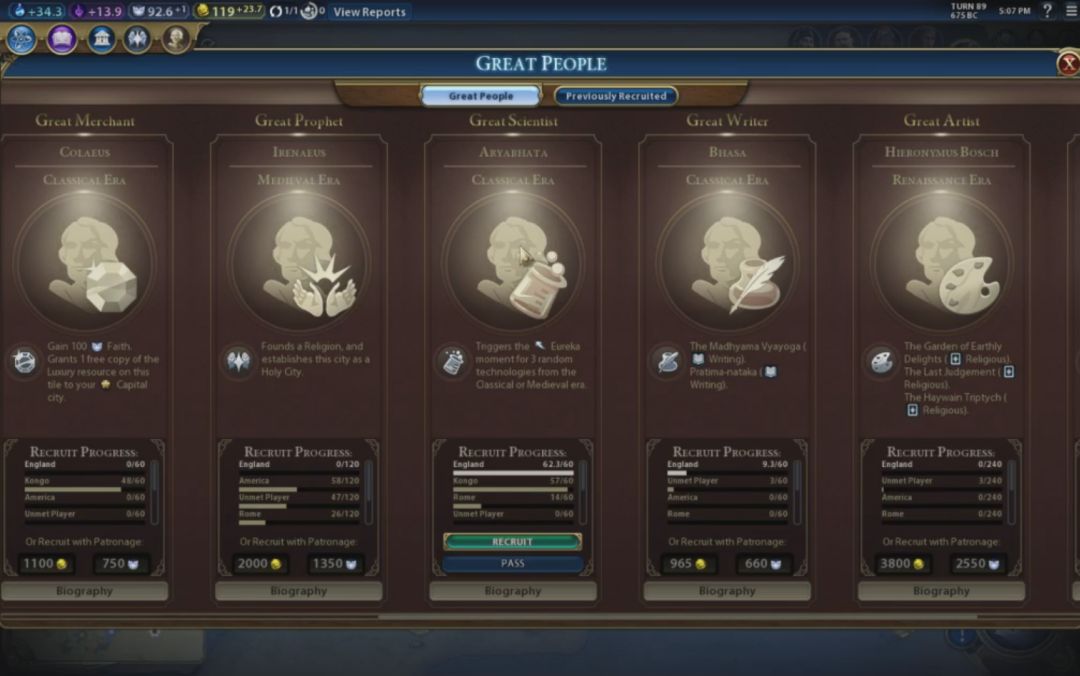
The Great Person system essentially works the way that it did in the Sid Meier's Colonization game. Each civ builds up Great Person points of the appropriate type, and whoever has enough gets first claim on that type of Great Person. You have the option to pass on a particular Great Person if you don't like what they do, however there's no way to know what the next Great Person behind them will have for an ability, and you can't claim the next Great Person until the first one is taken. On lower difficulties, you may end up waiting a long time for one of the AI empires to claim a Great Person if you pass up the first one! Probably best to claim the Great Person when offered so that you can get started working on the next one.
I think this system itself works fine as a mechanic. However, the Great People themselves feel very weak to me. For example, the Great Scientist in question here triggers a boost for three random techs, huh? That's ok, I guess? This turns out to be pretty typical of the Great People in Civ6. Most of them have some sort of minor benefit without being all that interesting or powerful. I'm disappointed that all of the Great People have only one use; what happened to Civ4, where all Great People have multiple uses and there's a real decision about using a Great Scientist for an Academy, a lightbulb, or a Golden Age? It's also disappointing that so many of the tech and civic boosts that come from Great People are "random" when used. Come on, at least let me pick the tech I want to use it on!  Again, the mechanic itself is fine in theory, looks like it needs more fine tuning through patches.
Again, the mechanic itself is fine in theory, looks like it needs more fine tuning through patches.
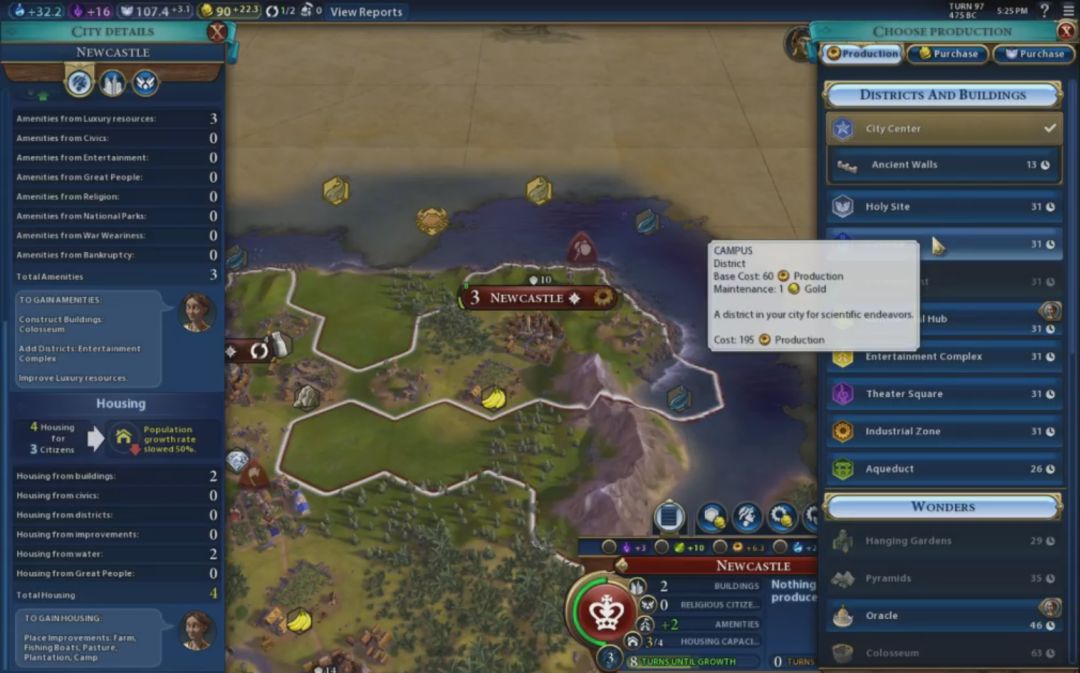
Here's another topic that's been getting discussed a lot in the Civilization community since release: the cost of districts. It turns out that the cost of districts are not fixed, and that they increase in cost throughout the game. This cost scaling is quite severe: notice how the highlighted Campus has a base cost of 60 production, but will actually cost 195 production here in poor Newcastle. Lots of new players are trying to construct districts in the lategame and getting 50 turn build times and other ridiculous stuff. Nowhere in-game does Civ6 explain why this is happening or what the player can do to stop the costs from going up by such a large amount. For the first few days after release, speculation was rampant about why this was happening. Was it based on number of cities? Number of turns played? The number of districts constructed in other cities? What was causing district cost to go up?
Eventually some players found the relevant portion of the coding that shed light on what was happening. Districts scale in cost based on total number of techs and civics researched. In other words, the more techs and civics that you finish, the more expensive districts become. This is... insanely stupid? The designers must have wanted districts to become more expensive over time, but this is one of the dumbest ways possible to accomplish that idea. It's illogical, it's never explained anywhere in the game, and it literally penalizes players for being successful. In fact, once you understand how this system works, the optimal way to play the game is to avoid finishing research on techs/civics, leaving as many of them as possible unfinished to avoid scaling up districts. The player should also throw down districts as soon as possible while leaving them unbuilt, as once the district is placed on the map it will not scale up in cost any further. The whole thing is profoundly dumb, and hopefully will be addressed through patching.
The one exception to this rule: unique districts are mostly immune to this scaling of district costs. That makes the unique districts the cheapest to build, by far, and therefore any civ with a unique district has a major advantage. This is why the Royal Dockyard is England's best ability, and I would indeed find that these unique district replacements for the harbor were vastly cheaper to build than anything else by the end of the game. The districts themselves are a great idea, their costs are simply all out of whack right now.
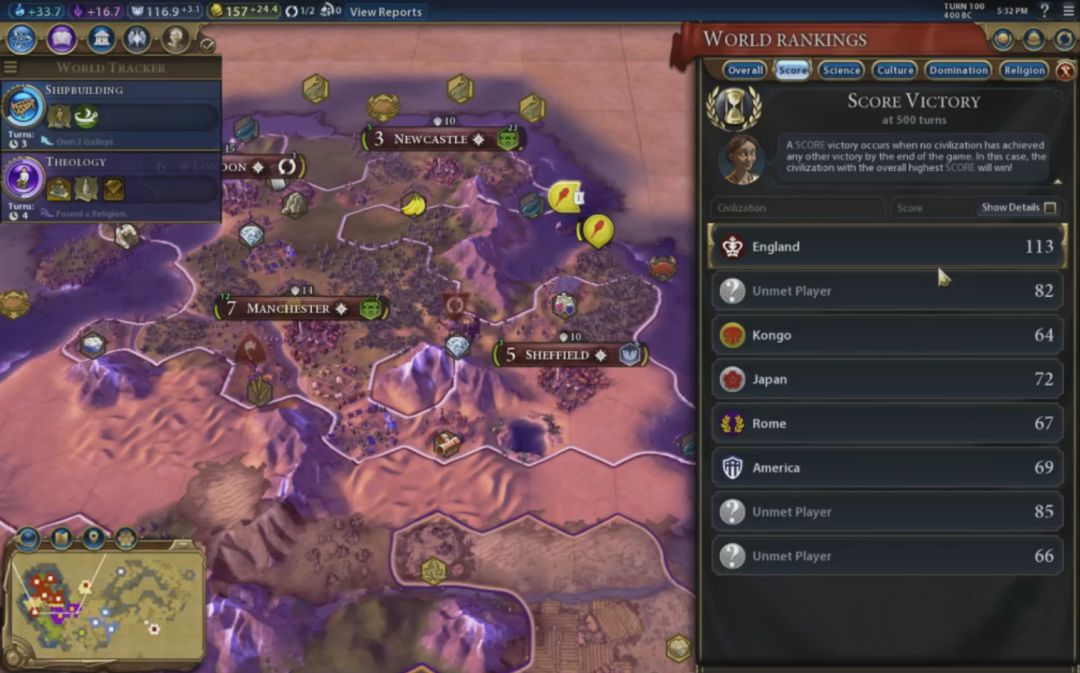
This was the situation 100 turns into the game. I had five cities in total (the last one offscreen in the desert to the south), and had emerged in the score rankings as the clear leader. I was close to double Rome's score already, largely because Trajan didn't seem to be doing much to expand. In fact, all of the AI leaders were generally sitting around, chilling on 2-3 cities apiece. Apparently they don't understand that Civ6 is back to being a game of expansion again; this is not Civ5 where you establish 4 cities and then never build anything else for the rest of the game. Someone needs to give them a kick in the pants and get them moving! The AI in Civ3 and Civ4 never had any problems expanding, and that's what we need in this game as well.
This narrative has gotten quite long already; click on to the next page to read the rest of the report in Part Two.



